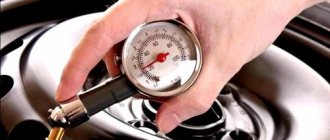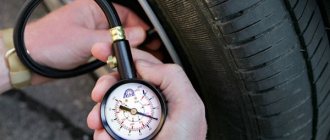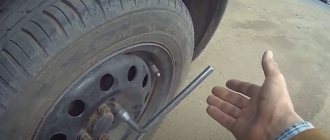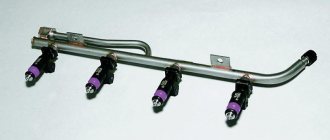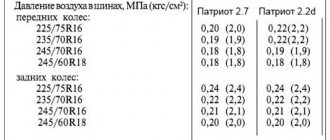The tire pressure of your car should be checked at least once a week. Modern tubeless tires are very sensitive to pressure, so reducing or increasing it in a tire by just 15-20% can increase its wear by up to 30% and negatively affect driving safety. Potholes, speed bumps, curbs - driving over them causes your tire pressure to drop.
We will tell you what pressure should be in a car's tires in winter and summer, and how changing it affects the car's behavior on the road and tire tread wear.
Below in the text you will find tables of tire pressures for cars by brand and wheel size, which present the most popular car models in Russia.
And it will be much easier for you to understand all kinds of symbols on wheels if you have at hand a decoding of the tire markings (indices of design, speed, tire load, etc.).
What pressure should be in VAZ tires
VAZ cars can be considered one of the most famous brands in the post-Soviet space. Today you can find both old VAZ-2106 and 2107 models. Samara 2109 and 21099 are quite common. Fans of the domestic automobile industry today purchase more modern models: VAZ 2110, 2112, 2114 and 2115 . This suggests that even with the appearance on the market of a large number of affordable foreign cars, cars from the Volzhsky plant have not ceased to be in demand among car enthusiasts.
It is important to always know the tire pressure of your car
In order for the service life of the car to be long enough, it is necessary to strictly adhere to all conditions of proper operation. Among the various factors that determine the proper use of a car, tire pressure is very important and significant.
The best way to pump tires
Just two decades ago, car enthusiasts had little choice. The only thing available was a hand pump, which was always kept in the luggage compartment of the vehicle.
The advantages of this option are simplicity and accessibility. The main disadvantage is high labor costs. On average, it is necessary to make about 110-130 up and down movements per atmosphere (for 13-14 inch tires).
After a while, a foot pump appeared, which was very easy to use.
Unlike the previous version, the hands were freed, and all the work was done with the foot.
The main disadvantage of such devices is their low reliability. After only 5-6 months of operation, the product simply failed (meaning inexpensive models).
Car enthusiasts breathed a sigh of relief when a compressor appeared - a special device that does its job independently.
All you need to do is plug in the device and observe the pressure gauge readings.
Once the tire pressure reaches the required value, you can turn off the compressor and hit the road.
But the downside of the first compressors was their connection to the household network.
Over time, compact products appeared that you could take with you on the road and pump up your tires at any convenient time.
The power supply for portable compressors is connected to the cigarette lighter or directly to the car battery.
Of course, the speed of inflating the wheel is less than in the case of a stationary compressor, but you can bring the tire pressure to the desired value at any time.
Car tire pressure, how important is it?
The manufacturer always gives recommendations regarding the tire pressure of the car. There is a special table where, depending on the model and type of tire, it is indicated what the value should be for different types of cars.
However, we should not forget that it also depends on load distribution, ambient temperature and other factors.
Control measurement of tire pressure on a VAZ 2106 car
With overinflated wheels we observe the following:
When the wheels are underinflated, the following phenomena are observed:
In both the first and second cases, tread wear increases. In the first case, the middle of the tread deteriorates, in the second, the sidewalls.
Review of the best summer and winter tires
It is better to acquire separate sets of summer and winter tires in advance. Pirelli Cinturato P1 Verde tires are ideal for the warm season. Their cost is relatively high (from 3,500 rubles per 1 tire). However, they perform excellently on wet asphalt and are highly resistant to wear.
- Continental Conti Premium Contact 5 is well balanced. There are a large number of special drainage channels - they make it easy to drain water from the contact patch. This kit will cost slightly less than the one discussed above.
- Goodyear EfficientGrip Performance provides good grip and low fuel consumption. However, the tread thins out quite quickly - especially during intense driving. The rubber is soft and handles well. Despite its softness, it is difficult to damage it redder.
- Dunlop Sport BluResponse is relatively cheap compared to all the options discussed above. However, it has its weaknesses. For example, on wet asphalt the wheels slip a lot and handling deteriorates.
- Semperit Comfort-Life 2 is a rare guest on Russian territory. However, on dry asphalt at positive temperatures it performs more than well. However, rubber is distinguished by its noise.
- GOODYEAR 175/70R14 UG ICE ARCTIC D-STUD - studded tires at a relatively low cost. Regardless of the ambient temperature, it retains its flexibility and softness. Cost – from 4,000 rubles.
- HANKOOK 175/70R14 W429 is a more budget option. Cost – from 2,800 rubles. Thanks to the deep tread and flexible design, the driver can feel completely safe on the road.
- KUMHO 175/70R14 WI31 84T usually costs several hundred rubles cheaper than the modification discussed above. The presence of studs makes this tire safe on almost any road.
- VIATTI TIRES 175/70R14 BRINA NORDICO is manufactured using rubber mixing technology. Reinforced lugs make this model indispensable not only in winter, but also on dirt roads in summer.
- SAVA 175/70R14 ESKIMO ICE MS is the most profitable option. It has a relatively low price (from 2,000 rubles). There are no thorns. However, the deep tread and its shape provide high-quality, reliable contact with any surface.
Choosing suitable tires for the VAZ 2110 is a relatively simple process. However, it is important to familiarize yourself with the intricacies of tire selection in advance. Wheels that are too large can easily damage the vehicle body.
Check your car tire pressure regularly
Owners of VAZ cars, like any other brands, are recommended to regularly check the level of tire inflation - at least once a month. Practice shows that over the course of a month the pressure decreases by 0.4 atmospheres. In this case, it is necessary to pump up the wheels.
To measure, you don’t have to constantly go to a service station - you can do it yourself using a pressure gauge. We do it this way:
Since temperature can significantly affect the readings, it is necessary to take them before leaving the garage on “cold” tires. Remember that regular monitoring is the key to your safety and long vehicle life.
WHAT IS THE RISK OF DEVIATION FROM THE SET PARAMETERS
Front-wheel drive cars of the Volzhsky Automobile Plant, such as the VAZ 2110, VAZ 2114 and VAZ 2115, can be equipped with wheels with a radius of R13, R14, R15 and R16, but the standard cars are equipped only with rims and tires of the 13th and 14th radius. The optimal tire pressure depends primarily on the load and weight of the vehicle; much also depends on road conditions and ambient temperature.
If the wheels are poorly inflated, then:
If the wheels are inflated more than normal, then this is also not very good:
Below are three pictures that show how the rubber tread adheres to the road at optimal, low and excess pressure.
Many car owners are wondering what pressure should be in R14 tires on VAZ models. According to technical conditions, the wheels on a VAZ 2114 (2115) car are inflated to 1.9 kgf/cm² (R13), on VAZ 2110-2112 cars it is recommended 2.0 kgf/cm² (R14). Moreover, it makes no difference what axle the wheels are on - front or rear.
Is it worth it or not to inflate your tires with nitrogen?
Recently, almost all tire stations have introduced the expensive service of filling tires with nitrogen. Its popularity is due to a number of the following opinions:
- Thanks to nitrogen, the pressure in the tires remains unchanged when they heat up.
- The service life of rubber increases (it practically does not “age”, since nitrogen is much cleaner than air).
- Steel wheel rims are not subject to corrosion.
- The possibility of tire rupture is completely eliminated, since nitrogen is a non-flammable gas.
However, these statements are nothing more than another advertising ploy by marketers. After all, the nitrogen content in the air is about 80%, and it is unlikely that anything can change for the better if the nitrogen content inside the tires increases by 10-15%.
In this case, you should not spend extra money and inflate the wheels with expensive nitrogen, since there will be no additional benefit, as well as harm, from this procedure.
Many novice car enthusiasts, after purchasing a vehicle, often have a question: what should be the pressure in tires with a radius of R15? Lack of proper experience and professional knowledge in operating a car very often becomes the reason for the owner’s elementary forgetfulness to check the pressure in the car’s tires.
As a rule, this is considered a serious error and directly affects the controllability of the vehicle, which can lead to a serious emergency situation on the road and dire consequences. But let's talk about everything in order.
INFLUENCE OF WEATHER CONDITIONS AND ROAD FACTORS
The pressure in VAZ tires in summer should, in principle, be the same as in winter. But in practice in winter it is made a little lower for a number of reasons:
It is necessary to take into account the fact that after a temperature change (after leaving a warm garage on a frosty street), the pressure in the R14 tires will become less due to physical factors. Therefore, you should check it before you hit the road and, if necessary, pump up the tires. Also, when it gets warmer after winter, pressure measurements should be taken.
The pressure in R13 tires in summer is usually maintained at 1.9 atm, but this level is designed for an average vehicle load (two or three people in the cabin). If the car is fully loaded, then the pressure should be increased on the front axle to 2.0-2.1 atm., on the rear axle to 2.3-2.4 atm. The spare wheel is inflated to 2.3 atm.
Russian roads are not of good quality, and therefore many car owners deliberately lower the tire pressure somewhat so that all the unevenness of the road surface is not so noticeably felt when driving. Typically, in summer the wheels are lowered by 5-10%, and in winter by 10-15% of the norm. On flat roads you can stick to the factory standard.
How does the type of tire affect the pressure?
You should know that the tire diameter does not affect the pressure indicators - for tires r13, r14 and r15 it will be the same. The degree of load on the wheels plays a role here.
It should be borne in mind that if there is a temperature change, for example, if you drive from a warm place to a cold one, the tire pressure may become lower. In summer they should have about 1.9 atmospheres at average load. If the car is fully loaded, the tires should be inflated to 2.1 atmospheres.
LARGER DIAMETER WHEELS
From the factory, the installation of wheels with diameters R15 and R16 is not provided, but some car enthusiasts, in pursuit of fashion and improved technical characteristics, install them on their VAZs. And accordingly, you need to know what the pressure should be in the R15 tires, and what the pressure should be in the R16 tires. It all depends on the workload of the VAZ model. With an average vehicle load, the wheels are inflated to 2 kgf/cm²; on a loaded car, it is better to inflate them to 2.2 kgf/cm². And if there is a lot of heavy luggage in the trunk, then the rear tires are pumped up by another 0.2 kgf/cm². It turns out that the pressure in R14 tires is approximately the same as the pressure in R15 and R16 tires (for VAZ 2110-2115 models).
Optimal tire inflation for various situations
In this section we will talk about what pressure should be in the tires of a VAZ 2114 passenger car with a 14 radius in the summer and why. This information applies to wheels of other sizes, taking into account that the larger the rim diameter, the more the tire needs to be inflated. Increasing the size by 1 inch (instead of R13, put R140), increases the requirement for air compression inside the tire by 0.1–0.2 atm.
In summer on a dry asphalt road
To drive on a dry asphalt road and air temperature above +10 degrees and a standard load (5 people, each weighing 70 kg and 50 kg of cargo), the tires of a VAZ 2114 13 radius passenger car in summer should have a pressure of 2–2.2 atm in the front and 2 ,2–2.4 atm at the rear.
METHODS OF MEASUREMENT
How to measure the tire pressure of VAZ cars? The measurement can be made using a special dial pressure gauge, but it should be noted that they may have an error of 0.2 atm. The pressure gauge can be either a separate device or as part of a wheel inflation pump.
We measure the pressure very simply:
It is recommended to take measurements at least once a month if the machine is used regularly. It is recommended to check tire inflation before leaving the garage after a long stay.
Pressure may increase when tires heat up. This often happens if the driver prefers a dynamic driving style with frequent and sharp braking. Therefore, measurements are taken on the car before the trip, when the wheels have not yet warmed up.

